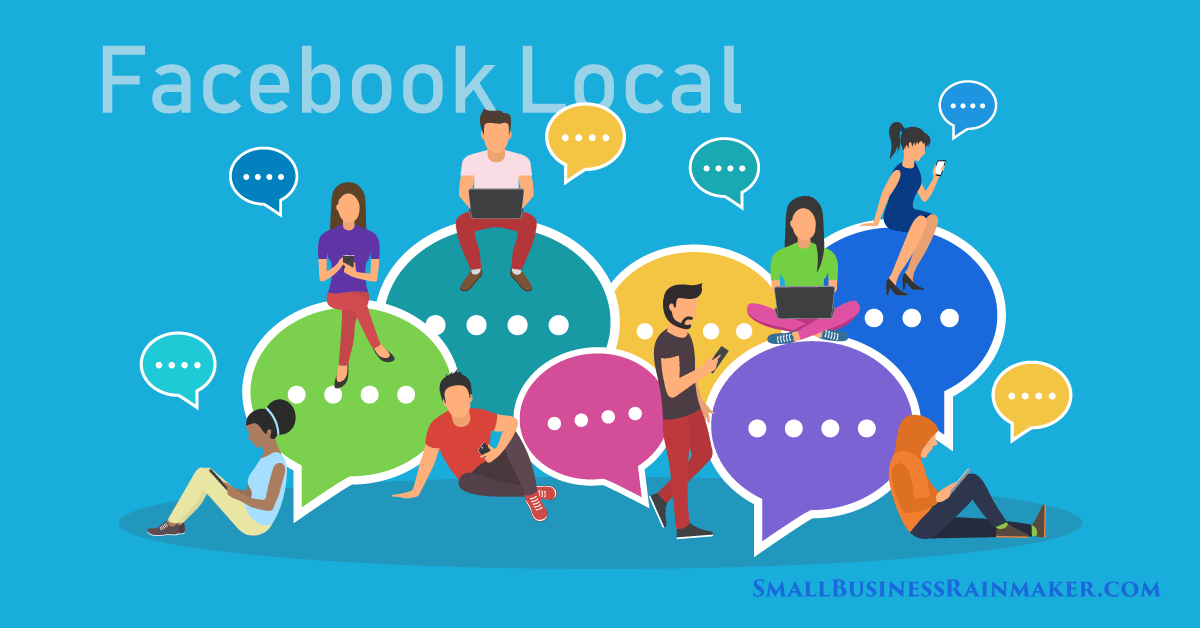
There’s a lot of advice about growing your Facebook audience. There isn’t much (detailed) advice from a local standpoint.
It’s a lot harder to get people to come to your local office, gym, or studio instead of your website. Your prospects are limited, therefore there’s a higher risk in conducting a local search marketing campaign.
What do you do?
You make sure that what you have to offer is talked about, remembered, and recommended more than what your competition has to offer.
How do you do it?
Assuming you already have a steady stream of clients, send them all friend requests. When a user accepts your friend request, the user automatically starts following you, just as you follow that user. They will start seeing your posts and when they engage with them, their friends will be able to see them too.
This way, the people who value your service most will do a splendid job as the starting point from which your audience of readers will grow.
The Steps to Grow Your Facebook Local Audience with Story Posts
The pace of growth depends on you doing 3 things well:
1. Stay top of mind
2. Address your prospects’ pains
3. Get readers to take an action (whether big or small)
You might be wondering:
Why am I adding people to my personal profile when I could invite them to like my Business Page?
Facebook strives for users to experience meaningful engagement with the people who matter most. That excludes your Business Page. It’s why on average only around 6% of people who ‘like’ your Page see its posts.
The Right (and the Wrong) Way to Stay Top of Mind
Have you seen posts like these?

They don’t get much traction.
This type of post doesn’t give people a reason to click through, comment, or share. It evokes no emotions and it solves no problems. Unfortunately, many Facebook Business Pages are littered with these types of posts. That’s why their number of followers stay the same or they go down.
If your competitors use this same “Spray and Pray” approach because they believe it’s the best way to stay top of mind, then you have an advantage. Instead of using the old way, the way that doesn’t get anyone’s attention, you’re going to build a narrative around your brand, and you’re going to start with one conversation at a time. That’s why it’s imperative to use your personal profile. People form relationships with people, not businesses.
The way to make those relationships last is by showing your reader you’re there for them in every post, comment, and engagement.
Make your readers feel like they have a big reason to give you their time. Are you giving them a life raft? (Some people need a little help to save themselves.) An alarm clock? (Others need to wake up and smell the reality.) They’re going to keep coming back to you for that one reason.
Stay top of mind by reminding them of that reason. Soon, they’ll start associating that you with the solution.
Address Your Prospects’ Pains with a Reminder
We’ve all got problems. Problems that we’ve had for years. Problems that we encounter on a daily basis. Problems that we have because of work. Situational problems. Problems we know we’ll have months down the road. We want to solve all of those problems, but we can’t solve them all at once.
We usually want to solve the ones that affect us most potently in our present situation. That’s unless we get distracted or reminded by a different problem, a problem that brings us more pain than the one we were previously experiencing.
Imagine that you’re scrolling through your feed. You read a post about wedding updates, see a shared video about a dog licking a baby, a status about the traffic, some ads (of course), and people asking for recommendations.
In that pile, there’s a percentage of content that your friends care enough to comment on, share, and even recommend to you. There’s a percentage of content that you care enough to comment on too. Not the type of comment that takes 3 seconds to write, but the kind that takes more than 3 minutes to think about.
The type of content that makes people want to leave well thought-out comments usually touches on a problem. The way it’s structured reminds people that their problem is more painful than they thought. That’s where your story-based Facebook post comes in.
Every time they see a post from you, it’ll act as a reminder that a problem they’re avoiding is giving them pain. They can’t make that pain go away until they do something about it.
Motivate Your Audience to Take an Action
You can’t grow an audience if you can’t persuade them to take an action, no matter how small the action. If someone clicks the ‘Follow’ button after reading one of your posts, that means you’ve motivated them to take a small action. It’s more likely that they’ll take larger actions going forward. That, in turn, will turn readers into loyal brand ambassadors and eventually, customers.
If you want to motivate your readers to take the right actions, your post has to stir up the correct mix of emotions. You don’t have to do it by trial and error. There’s a science that explains how posts go viral and it involves the use of high arousal emotions and low dominance emotions.
Why this combination?
High arousal emotions make us feel such that we are motivated to act. Low dominance emotions make us feel such that we have little control. This combination of emotions motivates us to get control.
The Geneva Emotion Wheel shows the science of which emotions give us a sense of higher control and which emotions give us a lower sense of control. On the left are negative emotions and on the right are positive emotions.
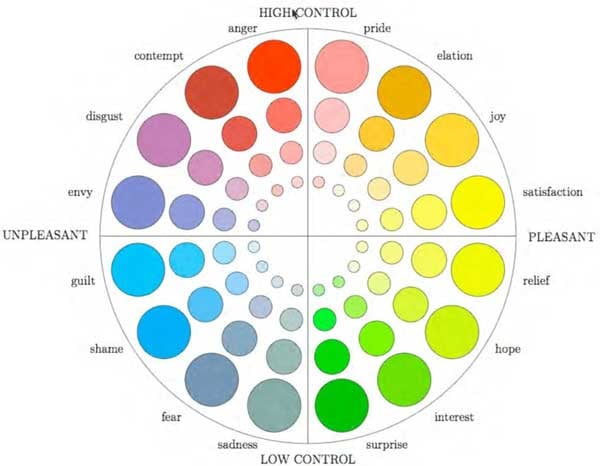
Negative high arousal emotions include anger, agitation, and disgust while positive high arousal emotions include excitement, inspiration, and pride. Create a post that elicits those high arousal emotions and “low control” emotions such as the ones shown in the wheel and you’ll get comments from readers expressing their fiery opinions.
The more opinions, the better. You’ll want both quality and quantity because of the way Facebook’s algorithm works. The big algorithm change in 2018 made it so that the platform encourages meaningful content rather than tags of friends and one-word comments. That means that content reaches more people when users leave comments that spark conversation and rattle up emotions.
The Facebook news feed algorithm ranks your piece of content based on these factors:
1. Inventory
2. Signals
3. Predictions
4. Relevancy Scores
Inventory — Whatever content the user has yet to see
Signals — Available information that helps the algorithm make predictions, such as the recency of a post, the author of a post, a user’s internet connection, or what type of device the user is on
Predictions — The likelihood of how much interest the user would have in a piece of content
Relevancy Scores — The likelihood of how relevant a piece of content would be to the user
So if a friend of yours with similar interests, age, location, language, etc. has commented thoughtfully on a recent post, it’s likely that it will show up in your news feed. It’s even more likely to show up in your news feed if more people with similar interests to yours have commented on it.
Why “Story-Based” Facebook Posts?
You want people to comment on your post? Get them to care enough to do so.
Well-crafted stories are perfect for achieving this aim. They have a strong introduction, a build-up of tension, and a final resolution. During this process, the reader starts to build a bond with the narrative. With this, the hormone oxytocin gets released, causing the reader to develop a sense of calm, trust, and psychological stability. It also lowers stress and increases the ability to bond.
This is the same hormone that’s released in the wake of exercise, sex, and other activities that give us pleasure. That’s why if a story is well-written, we feel deeply for the lives of the characters. We’ve built a bond such that we feel like we know them.
You can get your readers to feel deeply for the contents of your posts too. Even if you have a few hundred followers (for now). Even if you never achieved high scores in writing. Even if English isn’t your first language!
All you need to do is follow a formula.
You might be wondering:
How is this supposed to work for my business?
People buy because of emotion. They justify it with logic.
Even if your business is selling glass doors, wooden furniture, or sawmills, people are buying for the outcome, not the product or service itself. Your stories help readers to see how your product or service reaches their desired outcome.
Even if your product or service is un-sexy as a cardboard box, it’s better that people know about it, and attach a positive emotion to it, rather than take hours to search Google for competitors.
How to write posts that get people to take the action you want even if English isn't your first language
There’s a misconception that you can’t persuade people if you write grammatically incorrect sentences. This couldn’t be further from the truth.
There have been many advertising campaigns that succeeded with grammatically incorrect slogans. Remember these?
“Think Different”
“Eat Fresh”
“Got Milk?”
“ReThink Possible”
Apple, Subway, Milk, and AT&T all employ grammatically incorrect slogans.
This isn’t to say that you should throw grammar out the window immediately. You just shouldn’t get caught up in every word at the top of the funnel. That gets more important as you get towards the sale. It takes much more to convince someone to buy rather than to leave a comment.
When you get people to the bottom, that’s when you should be most concerned about grammar. The bottom of the funnel is for the offer. The top of the funnel is all about the story and associating certain feelings with your brand.
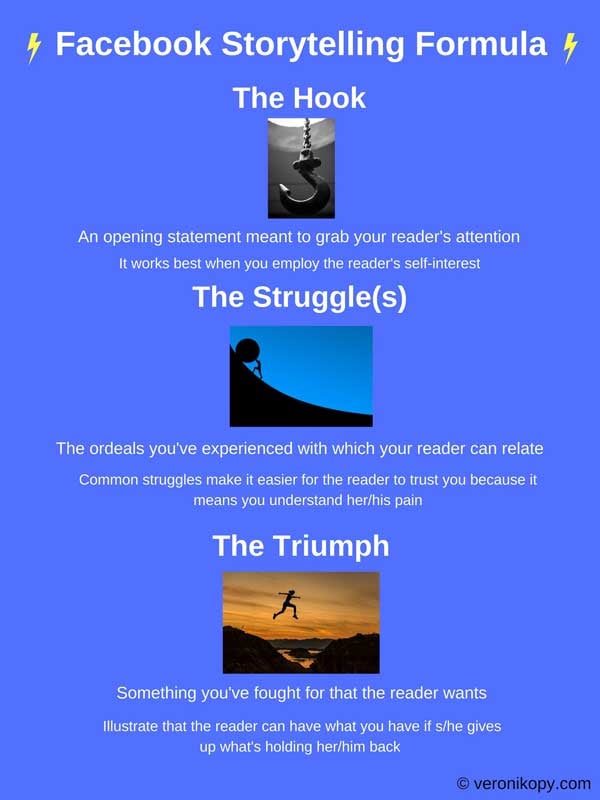
1. The Hook
The job of “The Hook” is to get people interested enough to read the next sentence. So, appeal to that which interests the reader most. Make the claim bold, controversial, and/or relatable. You are trying to get people motivated enough to seek control.
Start with a short sentence, question, or fact. Processing something small at first will motivate the reader to continue towards the larger chunks of text and bigger ideas
Remember that you’re trying to remind your reader of a problem they’re avoiding. Bring up the outcomes of that problem in a specific way.
Example 1
Daniel Bordman is a Canadian political commentator and author for news outlets such as The Post Millennial and Never Again Canada. Politics is already a difficult subject to talk about on Facebook but over the course of a year, he’s managed to attract over 5,000+ readers and gotten partnerships with many news outlets. Not bad for someone starting off with a whiteboard and a ferocious love for the truth.
This Hook gets people’s attention because it’s controversial. He’s taking a firm stance on something so that he can get loyal followers from one side and scare away the other side.

Here’s how Daniel’s post performed:
Example 2
Jimi is the co-founder of Code 5 Fitness Gym in New South Wales, Australia. His posts are motivating like this one, challenging people to give up the things that are holding them back.
This Hook gets attention because it forces people to reconsider their priorities. It’s relatable in the fact that a lot of people get less done because of wasting their time watching TV.

Here’s how Jimi’s post performed:
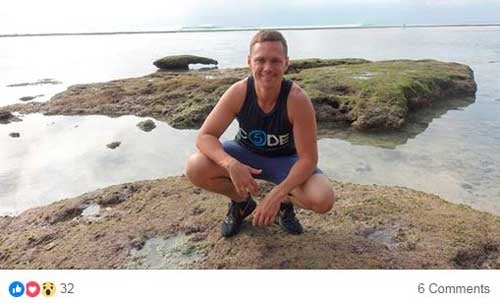
Example 3
Andrei Zinkevich is the founder of GetLeado, a B2B firm that services technology companies. He’s also been able to co-create one of the most engaged and valuable Facebook groups for marketers I’ve ever seen (B2B Marketers and Founders—I highly suggest it). While he isn’t a local example, his Facebook (and LinkedIn) posts have succeeded in getting him talks in his area.
This Hook is an attention-grabber because it points out a common misconception of many people: that LinkedIn is just an “online resume.” This makes people read how Andrei got from 0 to more than a few thousand in one year.
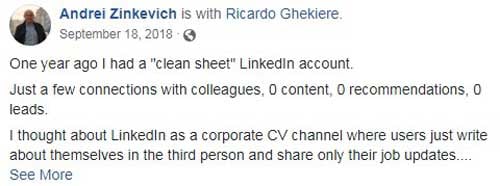
Here’s how Andrei’s post performed:
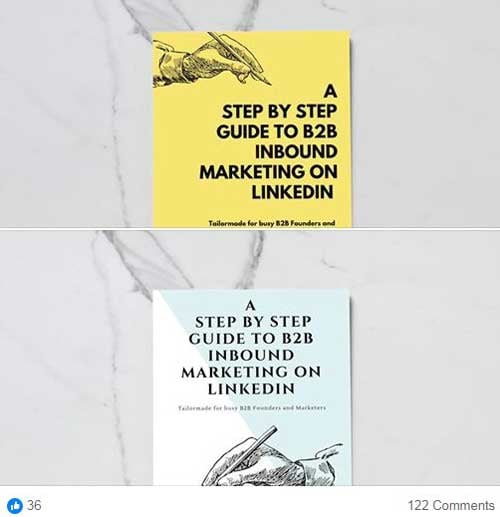
Now it’s your turn to write a Hook. Below are some sentence starters you can use that appeal to the reader’s self-interest and make them feel like they’re on the same level as you. If you’re feeling ambitious, continue with a question to your reader, offer an example, or illustrate the situation further.
When [a relatable thing that happened], I was lost.
I never thought I would [thing the reader really wants back] again.
X years ago I was [vulnerable position you were in that made you believe you wouldn’t achieve your goals].
[Thing that most people think is true, except for your reader] can’t last forever. It shouldn’t.
You’re never going to get [thing your reader wants] if you continue to [thing your reader can’t give up but needs to because it’s impeding them from succeeding].
2. The Struggle
The bulk of your post will lower your readers’ barriers. You can achieve this by showing your reader that you have been in their shoes countless times before. Show the reader that their goal is not as hard to reach as they previously thought because if you can reach the goal, then so can they.
Show your reader that there is a reason they have yet to reach their goal. It often involves giving up things they’re currently unwilling to give up: TV, fancy dinners, time, their beliefs, etc. What is your reader most unwilling to give up? Mention that and it’ll resonate with them most.
What makes the best book, TV, and movie series so appealing?
Problems.
Because we are curious creatures, we crave the solutions to these problems.
So give your post one big problem, or keep throwing lots of problems into your post.
3. Triumph
Your content will lead up to the reveal of your triumph over everything you’ve endured. Describe it in the words your readers would use so that they can see how they can get the same.
No post is complete without a call-to-action (CTA). This can be getting your reader to comment about a similar story, get them to do an exercise, get them to ask you a question, etc.
Here are some examples of CTAs with which you can end your post (depending on the relevance):
- What’s something that’s holding you back and why?
- Try xyz right now and comment on what gets in the way.
- What makes you lose focus when you’re trying to accomplish [thing your reader wants]?
- What would you rather do: A or Z?
- What’s your biggest worry about [thing your reader wants]?
How Will my Audience See This?
Your posts won’t work nearly as well unless the people whose problems you’re trying to solve can see your posts.
Otherwise, you are yelling into a forest when no one is near.
What do you do?
You can’t start adding people aimlessly. They have to come of their own persuasion. People will start adding or following by of one of two ways:
1) They see friends engaging with your posts.
2) They see your posts in the Facebook groups they spend their time in.
Join Facebook groups with high engagement + many followers
There are many reasons to join a Facebook group:
- It’s included in an online course you recently bought.
- It’s a great way to find out about community events.
- It’s an awesome motivational tool for fitness, nutrition, learning, etc.
- You want to keep up with your industry.
- You want to connect with people in your industry.
- You want some questions answered.
- You need it for market research.
Summed up, you can say people join a group for two primary reasons:
1. A sense of community
2. Staying “in-the-know”
In a Closed group after you scroll past the ‘About’ and ‘Members’ sections, you’ll see the ‘Activity’ section:
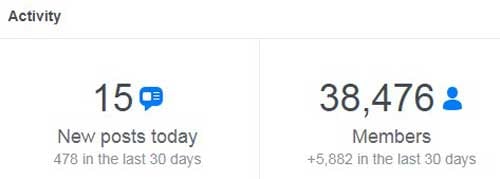
Looks like this group is active and growing fast. That’s a good sign that there’s low spam as well. A group only grows fast when it’s valuable.
In a Public group, you’ll be able to see all activity without asking to join. This will immediately give you a sense of whether it’s worth your time to build an audience in that group or not. If you see posts like the one below (first photo), you might think to steer clear. However, if there are people looking for recommendations in the same group, it looks like they use the group as an important source to find out about businesses around them that can help (second photo).
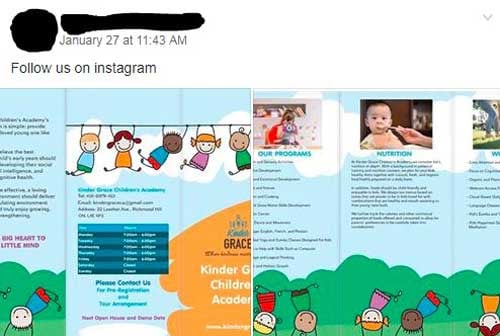
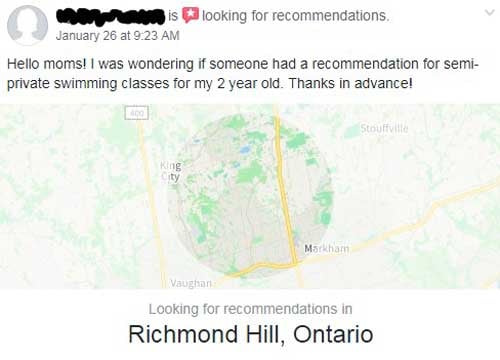
Remember not to just join groups that include people in your industry. You don’t want to build an audience of people in your industry, but of people who would eventually buy from you. For example, if you’re a fitness trainer, your primary Facebook group shouldn’t be one with a bunch of other fitness trainers. That’s your competition. Unless you sell to fitness trainers.
Find Facebook groups of people in your area who would need your product or service. Think about your existing clients: What’s their profession? Does it put such a strain on them that your business solves their problems? What about their personal lives? Maybe something goes on in their personal lives that drove them to use your services.
For example, if you make ready home-cooked meals, that would greatly interest people who have trouble making healthy food for their families or doing so in time. Entrepreneurial moms and dads would love that. Maybe office managers of small companies would love it too.
If you offer speaking classes, join Facebook groups with people who long to speak like Tony Robbins. Find out what kind of people need to be able to speak with confidence at work or with clients. From firsthand experience, I know that writers can always use some more confidence when it comes to speaking.
The point is, find those groups of people whose lives you’d make the biggest impact on.
What to Expect When You Start Using This Method to Grow Your Facebook Audience
You may not get followers the first day…
Or the second.
But the moment you start posting, you need to track your growth. If you don’t, that’s when engagement, followers, and comments become vanity metrics.
You should track things such as:
- What time of day you post
- # of comments per post
- # of new people commenting on a post
- # of new followers gained after each post
- # of messages you’ve received for the week
Your spreadsheet should link back to your Facebook post in each row of metrics so that you can go back and examine why you got the kind of metrics that you did. Most comments should be positive but there will always be one or two bad apples. When you’re dealing with negative comments, remember that it’s usually not about you and you shouldn’t take it personally.
It might take you a few days to try out different formats, times of day, best hooks, etc., but once you do, keep going. It’s challenging to post every day, but if you start by posting every day for 30 days, then you’ll get used to it, see results quicker, and understand faster what it is your audience wants to read and what they don’t.
One thing’s for certain though: you can’t start any of this without understanding your reader’s pains. If you know your reader as well as your route to work, then you have no reason not to start growing your local Facebook audience through story-based posts TODAY.
Get to it.

Our guest author Veronika Kabarguina is a copywriter and content strategist who helps SaaS companies position their product in a way that gets readers motivated to learn more and excited to buy. You can reach Veronika on LinkedIn or Twitter @veronikopy.













Leave a comment